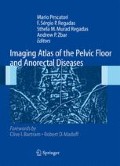Abstract
Although considered an indirect test to evaluate colonic motility, colonic transit-time assessment provides a definition for constipation by converting an otherwise hopelessly subjective symptom to an objective part of the medical record. Its most important role lies in excluding factitious constipation; however, its association with video defecography is crucial. Additionally, colonic transit times can help uncover causative diagnoses by stratifying motility disorders into two main patterns: colonic inertia and outlet obstruction. Several factors, including diet, physical activity, and psychological and hormonal factors may affect digestive transit-time results; therefore, some variation is expected. The most commonly used technique to measure colonic transit time involves two abdominal radiographs taken on days 3 and 5 after a single-day ingestion of 24 solid radiopaque markers.
Access this chapter
Tax calculation will be finalised at checkout
Purchases are for personal use only
Preview
Unable to display preview. Download preview PDF.
References
Hertz AF, Morton CJ, Cook F et al (1907) The passage of food along the human alimentary canal. Guy’s Hospital Reports 61:389–427
Labayle D, Modigliani R, Matuchansky C et al (1977) Diarrhee avec acceleration du transit intestinal. Gastroenterol Clin Biol 1:231–242
Alvarez WC, Freedlander BL (1924) The rate of progress of food residues through the bowel. JAMA 23:576–580
Dick M (1969) Use of cuprous thiocyanate as a short-term continuous marker for faeces. Gut 10:408–412
Kirwan WO, Smith AN (1974) Gastrointestinal transit estimated by an isotope capsule. Scand J Gastroenterol 9:763–766
Krevsky B, Malmud LS, D’ercole et al (1986) Colonic transit scintigraphy. A physiologic approach to the quantitative measurement of colonic transit in humans. Gastroenterology 91:1102–1112
Hinton JM, Lennard-Jones JE, Young AC (1969) A new method for studying gut transit times using radiopaque markers. Gut 10:842–847
Martelli H, Devroede G, Arhan P et al (1978) Some parameters of large bowel motility in normal man. Gastroenterology 75:612–618
Arhan P, Devroede G, Jehannin B et al (1981) Segmental colonic transit time. Dis Colon Rectum 24:625–629
Martelli H, Devroede G, Arhan P, Duguay C (1978) Mechanisms of idiopathic constipation: outlet obstruction. Gastroenterology 75:623–631
Jorge JMN, Habr-Gama A (1991) Tempo de transito colonico total e segmentar: analise critica dos metodos e estudo em individuos normais com marcadores radiopacos. Rev Bras Colo Proct 11:55–60
Cohen S, Vaccaro C, Kaye M, Wexner S (1994) Can segmental colonic transit times be reproduced with reliable results? (Presented as a poster) In: 93rd Annual Meeting of the American Society of Colon & Rectal Surgeons, Orlando, 1994
Jorge JMN, Wexner SD, Ehrenpreis E (1994) The lactulose H2 breath test as a measure of orocecal transit time (OCTT) Eur J Surg 160:409–416
Jorge JMN, Habr-Gama A, Yusuf AS et al (2001) Physiologic investigation of constipated patients with Chagas disease. Colorectal Dis 3(1):86
Bouchoucha M, Devroede G, Arhan P (1992) What is the meaning of colorectal transit time measurement? Dis Colon Rectum 35:773–782
Nam Y-S, Pikarsky AJ, Wexner SD (2001) Reproducibility of colonic transit study in patients with chronic constipation. Dis Colon Rectum 44:86–92
Basile M, Neri M, Carriero A et al (1992) Measurement of segmental transit through the gut in man. A novel approach by the biomagnetic method. Dig Dis Sciences 37:1537–1543
References
Devroede G (1994) Psychological considerations in subjects with chronic idiophatic constipation. In: Wexner SD and Bartolo DCC (eds) Constipation: etiology, evaluation and management. Butterworth Heinemann, London
Thaler K, Dinnerwitzer A, Oberwalder M et al (2005) Quality of life after colectomy for colonic inertia. Tech Coloproctol 5:133–138
Pescatori M, Pietroletti R, Anastasio G, Rossi Z (1992) Endocrine pathogenesis and surgical treatment of postcolectomy diarrhoea. Coloproctology 4:244–247
Author information
Authors and Affiliations
Rights and permissions
Copyright information
© 2008 Springer-Verlag Italia
About this chapter
Cite this chapter
Habr-Gama, A., Neves Jorge, J.M. (2008). Radiography and Radiopaque Markers in Colonic Transit-Time Studies. In: Imaging Atlas of the Pelvic Floor and Anorectal Diseases. Springer, Milano. https://doi.org/10.1007/978-88-470-0809-0_18
Download citation
DOI: https://doi.org/10.1007/978-88-470-0809-0_18
Publisher Name: Springer, Milano
Print ISBN: 978-88-470-0808-3
Online ISBN: 978-88-470-0809-0
eBook Packages: MedicineMedicine (R0)

